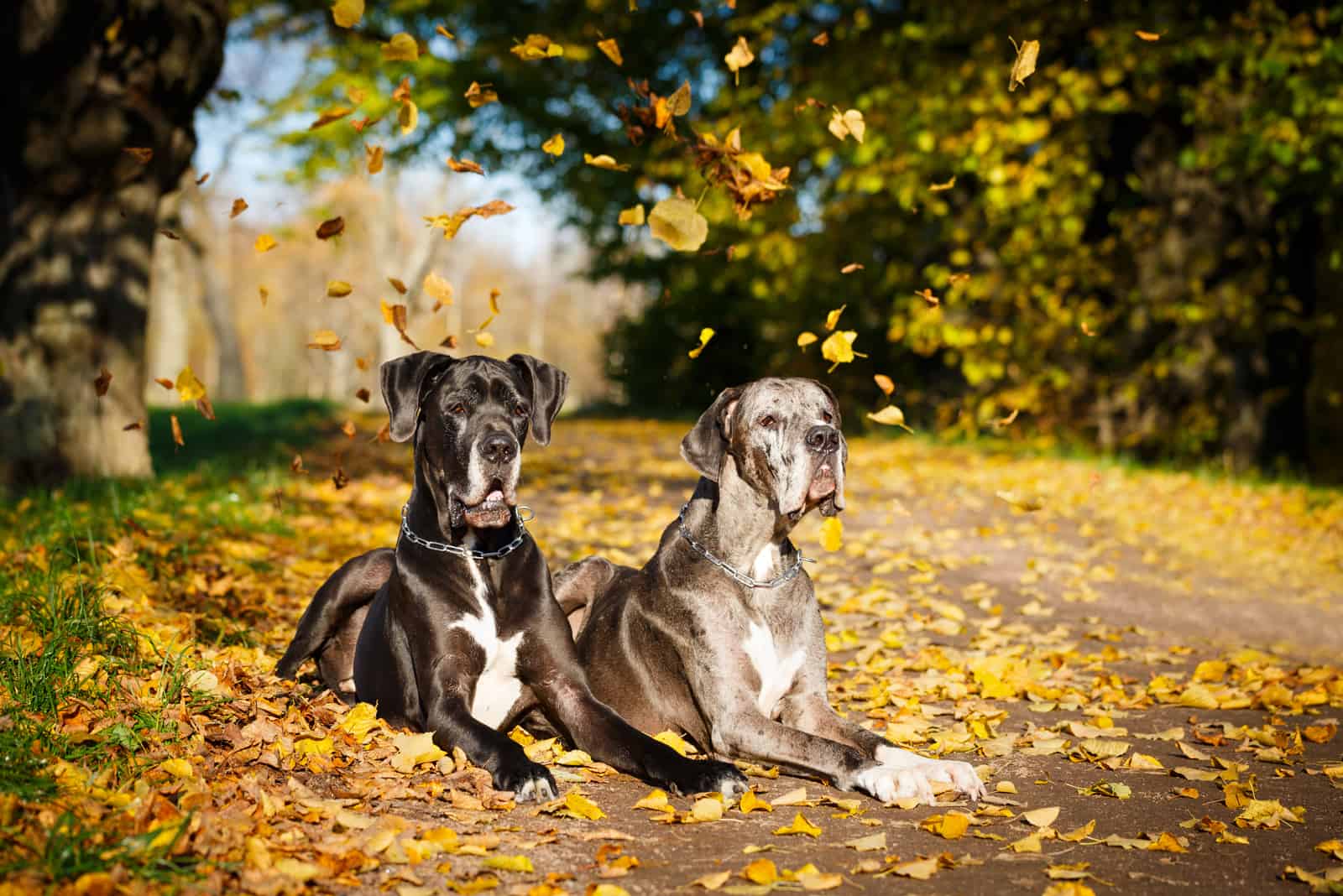Meet the largest dog breed registered by the American Kennel Club (AKC) — the Great Dane.
The Great Dane is often referred to as the gentle giant and the Apollo of dogs. And it has certainly earned that title.
The Great Dane’s weight and size might make it look intimidating for some people. However, everyone who has heard about this giant dog breed knows about its loving personality.
If you are wondering how large this giant dog really is, we have the answer!
This Great Dane growth chart describes the real size of this gentle giant. Not all numerical here, the Great Dane growth chart is not all pounds and inches.
Today we will follow the GD puppy through all of its developmental stages. Figuring out how it behaves as it is growing, as well as understanding common Great Dane health problems that come along.
Let’s get to know the Great Dane dog breed better!
Great Dane Puppy Growth Chart
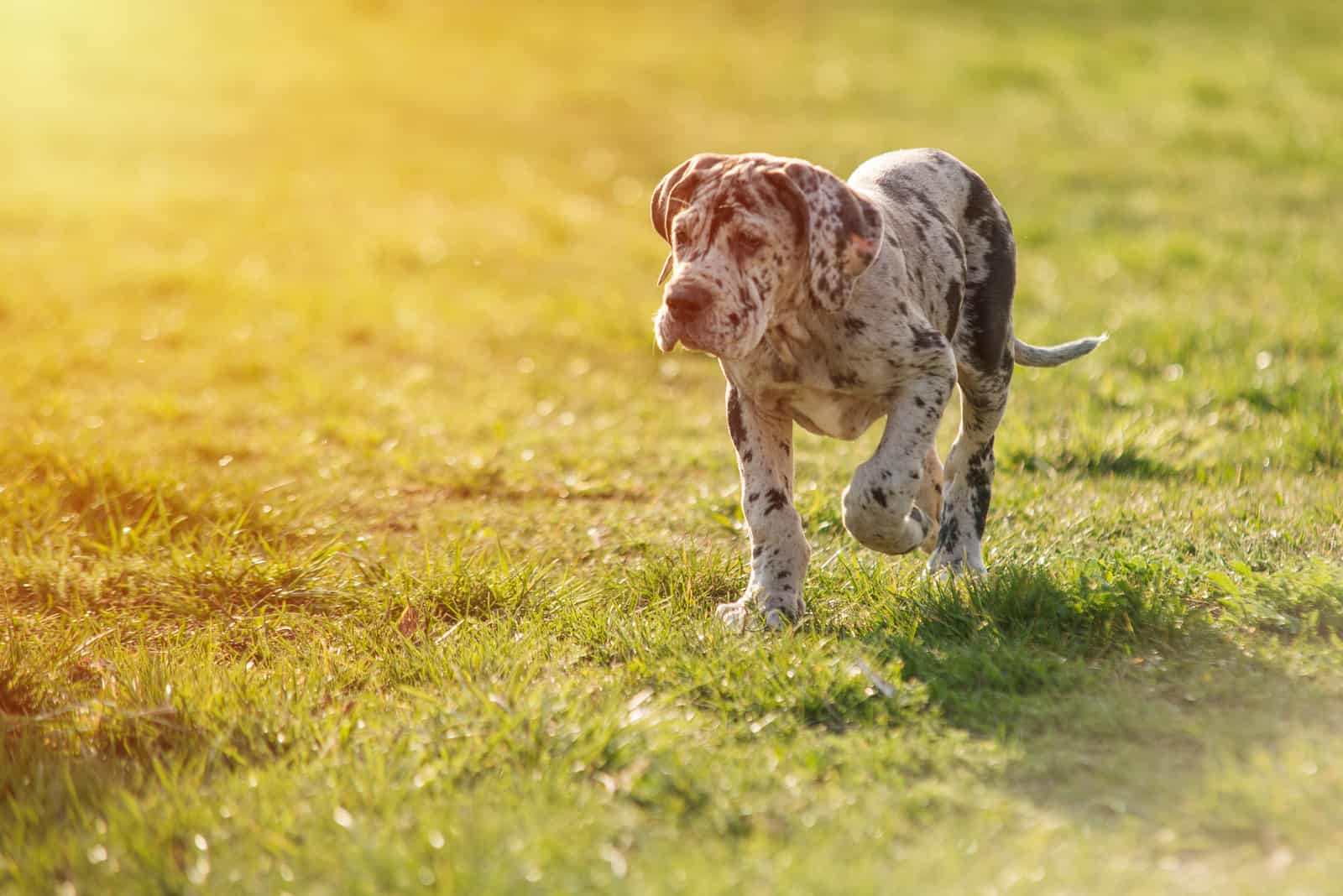
Without question, the Great Dane puppy is among the largest puppies in the canine world. We are a bit curious about how tall the Great Dane puppy gets. So, here is a Great Dane growth chart table to fulfill our curiosity.
| Age | Female Great Dane Size | Male Great Dane Size |
|---|---|---|
| 8 weeks | 14 -16 inches | 16 – 18 inches |
| 10 weeks | 15 – 18 inches | 17 – 20 inches |
| 12 weeks | 18 – 20 inche | 21 – 24 inches |
| 4 months | 22 – 24 inches | 24 – 28 inches |
| 5 months | 24 – 26 inches | 27 – 30 inches |
| 6 months | 27 – 28 inches | 30 – 33 inches |
| 7 months | 28 – 30 inches | 31 – 34 inches |
| 8 months | 28 – 30 inches | 31 – 34 inches |
| 9 months | 28 – 30 inches | 32 – 35 inches |
| 10 months | 28 – 30 inches | 32 – 35 inches |
| 12 months | 28 -30 inches | 32 – 35 inches |
| Over a year | 29 – 32 inches | 34 – 36 inches |
How much a Great Dane puppy grows in height is pretty impressive, right?
So, if a Great Dane puppy grows this tall, does it also weigh a whole lot? Let’s find out in the Great Dane puppy weight chart.
Great Dane Puppy Weight Chart
In order to understand this large dog’s growth stages, we ought to estimate the Great Dane puppy weight from birth to two years of age.
| Age | Female Great Dane Weight | Male Great Dane Weight |
|---|---|---|
| Birth | 1-2 lbs | 1-2 lbs |
| 1 week | 2-3 lbs | 2-3 lbs |
| 2 weeks | 3-5 lbs | 3-6 lbs |
| 3 weeks | 4-7 lbs | 5-7 lbs |
| 4 weeks | 5-8 lbs | 6-9 lbs |
| 8 Weeks | 18 – 22 lbs | 23 – 30 lbs |
| 10 Weeks | 22 – 30 lbs | 31 – 38 lbs |
| 12 Weeks | 30 – 48 lbs | 38 – 55 lbs |
| 4 Months | 48 – 62 lbs | 57 – 70 lbs |
| 5 Months | 62 – 75 lbs | 72 – 85 lbs |
| 6 Months | 75 – 84 lbs | 85 – 92 lbs |
| 7 Months | 82 – 86 lbs | 92 – 100 lbs |
| 8 Months | 86 – 90 lbs | 100 – 110 lbs |
| 9 Months | 90 – 94 lbs | 110 – 120 lbs |
| 10 Months | 92 – 96 lbs | 115 – 120 lbs |
| 12 Months | 100 – 110 lbs | 120 – 140 lbs |
| 24 Months | 115 – 120 lbs | 140 – 180 lbs |
If you are a proud owner of the majestic Great Dane dog and you happen to notice that your dog is bigger or smaller than these estimated dog weight values, there is no need to worry. Some Great Dane puppies grow faster than others, while some happen to stay small for some time.
As impressive as the Great Dane’s height is, so is its weight. Notice how there is a difference between a male and a female Great Dane. Let’s talk a bit more about this, shall we?
Female Vs Male Great Dane Growth Chart
Male and female Great Danes have a lot of similarities, but also a lot of differences.
According to the AKC breed standards, the female Great Dane’s full height measures between 28 and 30 inches, while the male’s height ranges from 30 to 32 inches.
Full size male Great Danes weigh between 140 and 175 pounds and females weigh a few pounds less (between 110 and 140 pounds).
Male Great Danes are taller and heavier. This is possible to determine at first glance, when there are the two of them standing right in front of you.
We clearly see that the female Great Dane is smaller and less heavy than her male Great Dane counterpart. However, there can be some exceptions. At times where female Great Danes get pregnant, they may look larger than males.
Another, more concerning state, is when a female Great Dane is obese. In some cases, a female Great Dane puppy receives better living conditions and more favorable growth factors. This way she will outgrow the male Great Dane puppy that hasn’t grown up in the same living conditions. However, the natural way in the canine world is that male dogs are larger than females.
Female Great Dane dogs are usually a few pounds lighter, and a few inches shorter. Honestly, it feels so unnatural to use the word “short” with “the Great Dane”.
Female Vs Male Great Dane: Similarities And Differences
Due to the fact that the Great Dane is a short-haired dog, there is not much difference in coat between a female and a male Great Dane dog.
Most people think that Great Danes don’t shed due to their short coats. Actually, the Great Dane is a high to moderate shedder. Consider getting the best Great Dane brush you can find to help reduce all the short hairs around the house.
Another thing that both genders share is a variety of coat colors. The Great Dane coat colors range from black, blue, brindle, fawn, to many other shades and hues. One of my favorites is the blue Great Dane coat color. It’s so unique as it makes this large dog look shiny and beautiful!
So, what are the differences between a male and a female Great Dane?
The main difference is the dog’s genitals, of course. In case you want to check the gender of your Great Dane puppy, simply check its genitals. However, if you are purchasing or adopting a Great Dane, you probably already know its gender.
Another key difference is that male Great Danes usually inherit a bonier structure. Of course, both male and female Great Danes have large and strong bones, but the male Great Dane’s skeletal framework is quite sturdy. On the other hand, female Great Danes look more feminine and sleek.
European Great Dane Vs American Great Dane
The European Great Dane and the American Great Dane are very similar in both appearance and temperament. So, how do you tell these two apart?
Firstly, the European Great Dane inherits a larger skeleton framework than the American Great Dane. That said, its appearance is larger and more sturdy. Along with massive bone structure, the European Great Dane develops more muscle mass to keep its large body going.
In contrast to European GDs, which may reach up to a whopping 240 pounds, the American Great Danes are lighter and smaller. Don’t get me wrong, the American Great Danes are by no means “small” dogs. They still reach up to 32 inches in height and weigh up to 175 pounds.
Besides differences in adult weight and height, the European Great Dane has more loose skin on its face and body.
When Do Great Danes Stop Growing
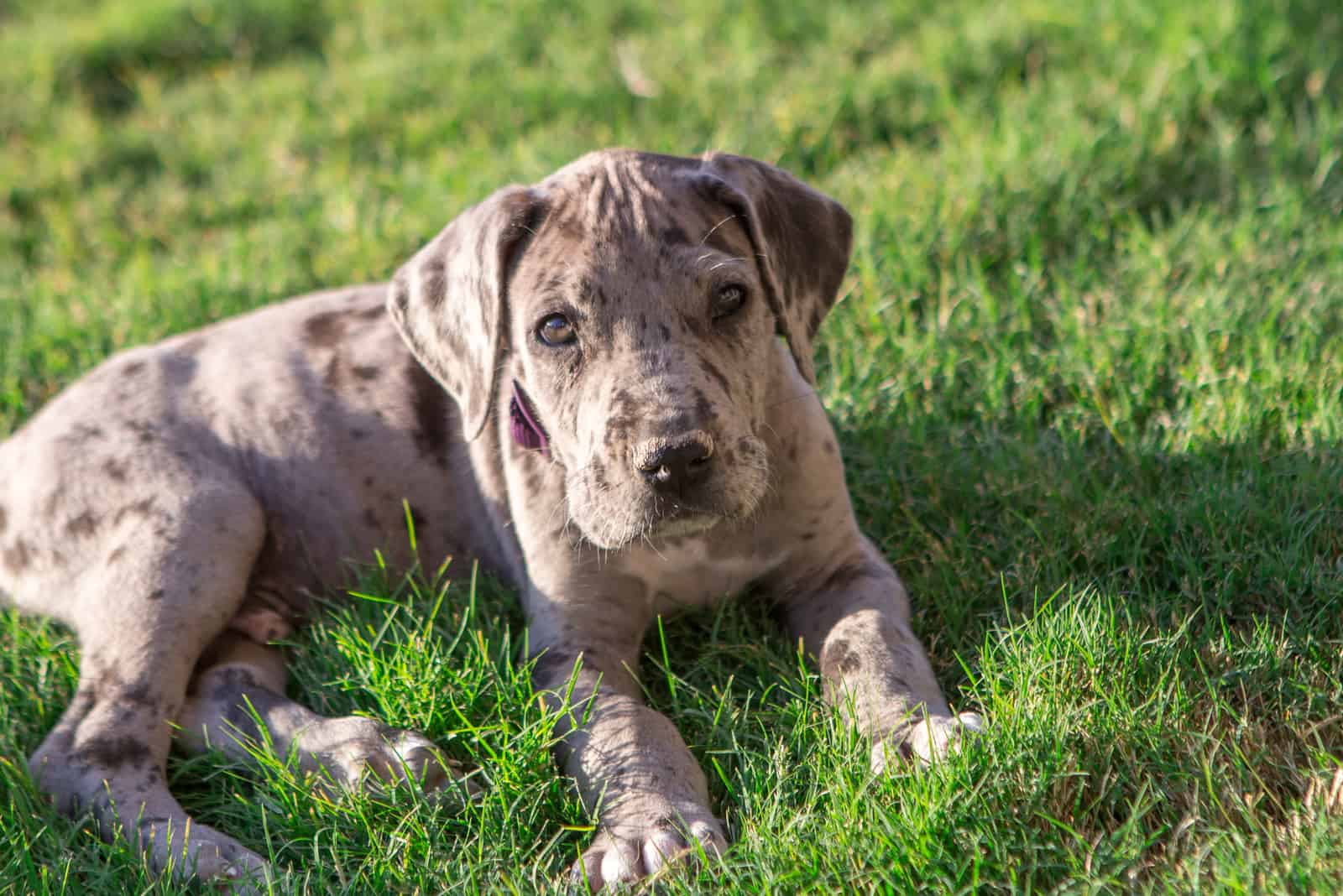
Honestly, the Great Dane is an enigma when it comes to this question. In reality, no one can really tell when Great Danes stop growing. There are many studies about large breed dogs that show rapid growth rates all up to the first year of life.
At What Age Is A Great Dane Fully Grown?
Most big dogs tend to slow down with their growth when they reach 18 months of age. Some Great Danes only stop growing when they hit the second year of life. Even though there is no exact answer to this question, we can assume that the Great Dane is fully grown when it reaches 24 months of age.
If you have had your Great Dane puppy for more than a year and if you’re curious if it will still keep growing, here’s what you can do.
Consult your veterinarian about your puppy’s growth. Your vet will do some X-ray checks to determine whether the growth plates inside the puppy’s bones are closed. When growth plates are closed, this means that the Great Dane dog has stopped growing.
What Is The Average Weight Of A Fully Grown Great Dane?
The average Great Dane adult weight typically ranges between 140 to 175 pounds. Compared to males, female Great Danes are lighter (110 to 140 pounds). However, some male Great Danes tend to weigh more than 200 pounds!
Great Dane Growth Rate

As you may probably already know, the Great Dane puppy has the most rapid growth rate among all other dog breeds. Some sources state that during the first year of its life, the Great Dane puppy grows as fast as a fourteen year old human does. So, one year old Great Dane equals a fourteen year old human in terms of physical growth.
During the first 55 weeks of life (which is a little over a year) the Great Dane puppy grows very fast. Once it reaches the first year of life, the Great Dane puppy is approximately at its 95% of adult size.
Perhaps the biggest growth rate percentage is noticed during the period between two and eight months of age.
How Tall Do Great Danes Get?
We often see photos of dog owners posing with their Great Dane dogs that are standing on hind legs. Even though this isn’t the right way to measure a dog’s height, everyone is curious how tall a Great Dane standing on its hind legs is. Well, it is safe to say that it can reach up to seven feet in height!
The correct way to measure the Great Dane is by measuring its height to its withers. An adult Great Dane can reach between 28 and 35 inches in height.
Did you know that the Great Dane isn’t actually the tallest dog breed? I was also surprised to find out that the Irish Wolfhound dog breed exceeds the Great Dane’s height by a few inches.
Just imagine how tall an Irish Wolfhound Great Dane mix would get!
How Do I Know If My Great Dane Puppy Is Going To Be Big?
Well, you already know that your Great Dane puppy is going to be a very large dog, according to the AKC breed standards.
If you have purchased a Great Dane puppy from a reputable breeder, he will let you know how big your Great Dane is going to get. When you look at past Great Dane litters, you can get the idea of how big your Great Dane puppy will get.
Following your GD puppy’s development, engaging in everyday activities and feeding your Great Dane puppy a high-quality diet, ensures that it will grow into a healthy, big dog.
Great Dane Puppy Growth Stages
Great Dane puppy growth stages are full of ups and…ups!
It seems as if this giant puppy keeps growing and growing. To catch up with its rapid growth pattern, we’re going to talk about each growth period.
We have divided the puppy growth stages based on puppy growth spurts. It is believed that Great Dane puppies go through four puppy growth spurts.
Let’s find out when and how they happen!
Birth To Four Weeks
Female Great Danes can give birth to many Great Dane puppies. In fact, the biggest Great Dane litter consisted of 19 puppies! On average, a Great Dane mother usually carries and delivers eight puppies.
At birth, the Great Dane puppy weighs between 1 and 2 pounds. At this point, both newborn male and female Great Dane puppies weigh the same. There is barely any difference in their appearance, size, and weight.
Progress in puppy development can already be seen by three weeks of age. These gentle giants are becoming more active, their eyes are opening and their little teeth are emerging. Now they weigh between three and five pounds.
By four weeks of age, the Great Dane puppies have developed all of their senses. They have also learned how to walk and use their voices. And, they are becoming big!
Four Weeks To Eight Weeks
We are entering the first puppy growth spurt period. The developmental Great Dane puppy stage from four weeks to eight weeks is the most important. This is the period of socialization and interaction.
The Great Dane puppies are curious to meet new human and animal friends. They are active, fun, and ready to go out on adventures! They are also a bit clumsy.
A four week old Great Dane puppy weighs from five to ten pounds. By eight weeks of age, the Great Dane puppy’s will more than double. It will weigh three times more than it did the previous month. An eight week old Great Dane puppy weighs between 15 and 30 pounds.
By two months of age, the Great Dane puppy rises to 18 inches in height.
Eight Weeks To Six Months
This period is one of the biggest Great Dane puppy growth spurts.
At eight weeks of age, most Great Dane puppies have already started with early socialization. And, if you are buying a GD puppy from a breeder, you will most likely get it when it’s eight weeks old.
What you can expect in upcoming days is that your Great Dane puppy will grow incredibly fast.
A four month old Great Dane puppy already weighs 45 to 65 pounds, standing between 20 to 25 inches in height. That’s the size of an adult Golden Retriever!
So, how big is a 5 month old Great Dane?
Well, it’s much bigger than the four month old Great Dane. A five month old Great Dane has grown up to 30 inches in height and reached 85 pounds.
Now you are probably wondering “How much bigger will my 6 month old Great Dane get?”
Waay bigger! Six months of age isn’t nearly close to its adult size. But, the six month old Great Dane already weighs 65 to 100 pounds and stands from 23 to 33 inches in height.
Six Months To Twelve Months
Now that your male Great Dane puppy has grown to six months of age, neutering your dog is an option. Great Dane puppies between six and twelve months of age are ready for neutering. They weigh between 65 and 150 pounds.
Female Great Dane puppies should be spayed when they reach their first year birthday. However, there is no need to hurry. Spaying female puppies too early may cause developmental health problems.
At twelve months of age, the Great Dane is near its adult size (almost!)
Older Than A Year
Some Great Danes reach their adult size when they hit 12 months of age. But, most keep growing until their second year.
After a year, male Great Dane puppy should weigh between 135 and 180 pounds, whereas his female counterpart weighs between 115 and 140 pounds. Both reach a massive height, between 28 and 34 inches.
Factors Affecting Great Dane Puppy Growth
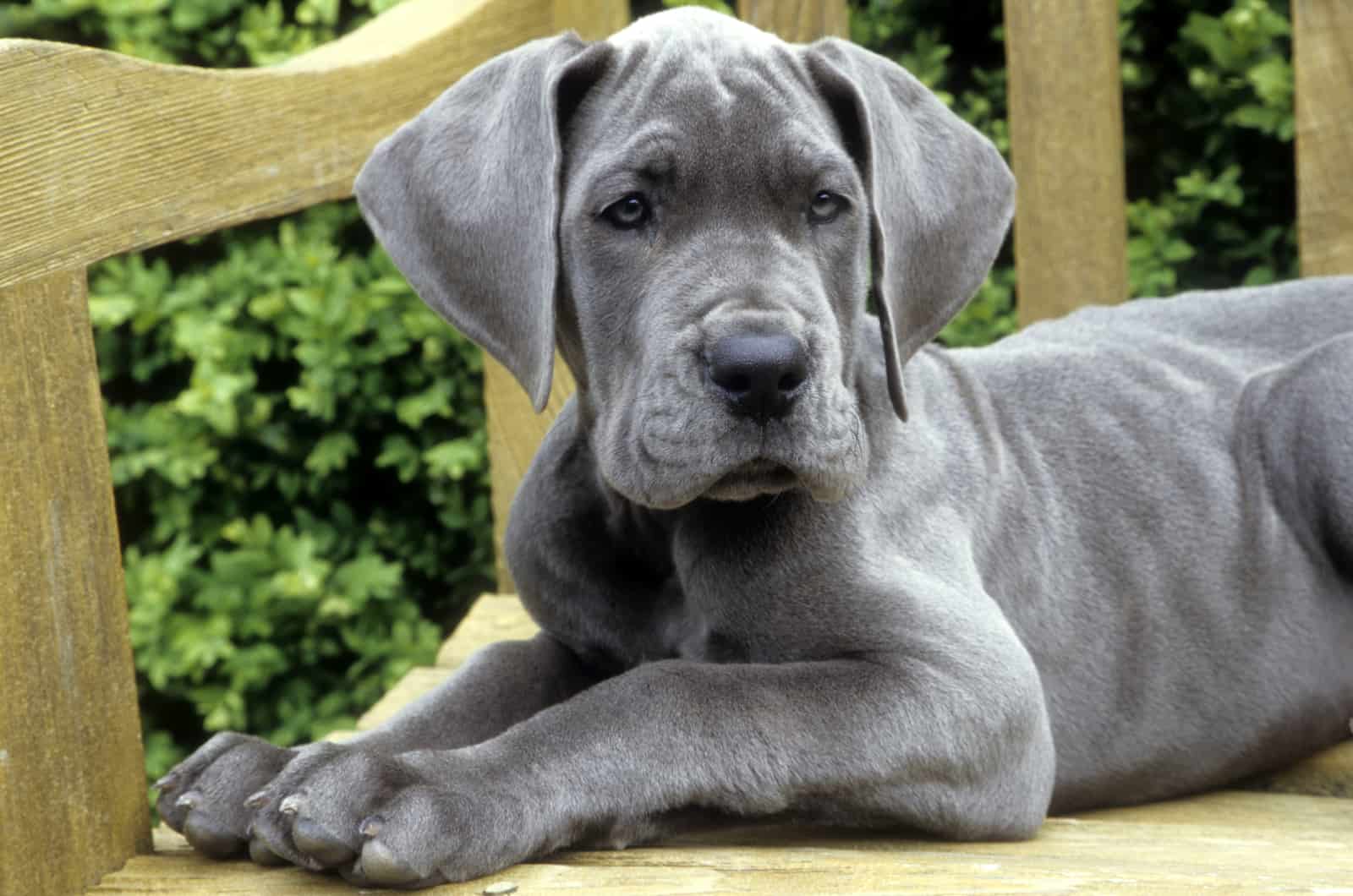
Great Dane puppy growth is a long and fragile process. By long I mean that it can sometimes take more than two years for this puppy to reach its full size. And by fragile I mean that there are so many factors that can affect the Great Dane puppy’s growth.
On one hand, these factors are controlled by you and the dog breeder. On the other hand, most factors are determined by nature itself.
Let’s see what makes the Great Dane puppy grow big and what might make it grow smaller than usual.
Genetics And Environment
The Great Dane carries specific genes for large size. With help of science, breeders were able to make the Great Dane a very tall and large dog. However, such selective breeding didn’t do much good to the Great Dane’s health.
Great Dane breeders carefully select the healthiest and most high-quality dogs to introduce into the breeding program. This way, their personality, health, and appearance traits are passed onto future generations. What this means is that the Great Dane puppies will have less health issues and less troubles during their growing up period.
Some breeders figured that crossing the Great Dane with other dog breeds results in healthier Great Dane mixes.
Diet And Nutrition
Alright, this one is extremely important for the Great Dane puppy. We are talking about a giant dog breed. How can a Great Dane puppy become a giant adult dog without a proper diet? No way!
Maintaining a good, high-quality diet helps the Great Dane puppy’s body to create strong bone tissue, proper muscle mass and healthy weight.
Nutrients found in quality puppy food, raw diet, and supplements, help the Great Dane puppy grow big and strong. These nutrients basically feed each part of the puppy’s body.
Not only does a good diet affect the Great Dane’s size, but it also helps protect this large dog from various diseases. Healthy Great Dane diet that is rich in proteins, vitamins, minerals, and healthy fats acts as the protector of its health. A strong immune system is created by the daily intake of necessary nutrients found in quality dog food.
As for meat, most dog owners and breeders recommend feeding the Great Dane a 100% raw diet. And it makes sense, since these large dogs used to hunt prey (which they would’ve probably eaten raw). If you are having second thoughts about feeding your Great Dane a raw diet, you can try boiling chicken for your pup.
Exercise And Socialization
Both factors affect the Great Dane puppy growth in one way or another. Exercise makes the Great Dane’s body develop faster and healthier. Healthy amounts of exercise grow longer bones, stronger muscles and healthy weight. Great Danes need strong muscle foundation in order to hold their big bones, joints, and ligaments.
Daily exercise is usually followed by socialization. There is no healthy physical growth without healthy mental growth.
Socializing such a large dog breed like the Great Dane is extremely important — not only to you and the dog, but to everyone around you. Even though almost no Great Danes that I know of are aggressive, there is always a possibility for poor socialization to lead to behavioral issues.
A dog’s aggressive behavior can be prevented with early socialization (as early as four weeks of age), and constant mental stimulation. Remember — your behavior contributes a lot to your Great Dane puppy growth.
Great Dane Health Problems
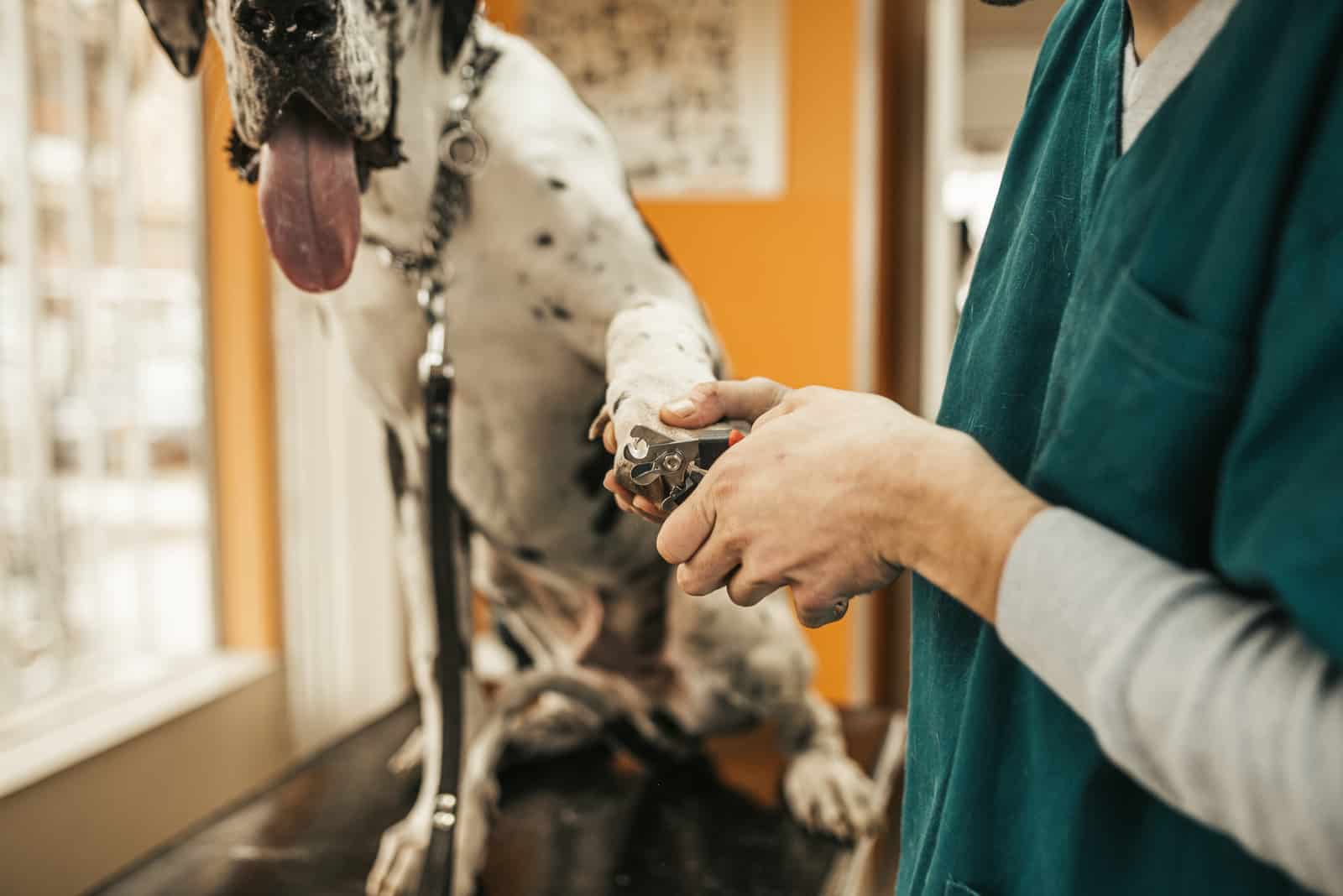
Most (if not all) of the Great Dane’s health issues are related to its large size.
You may wonder why do Great Danes suffer from so many health conditions and how does size actually affect their health?
Puppy growth spurts occur very fast and the dog seems to grow up in a matter of seconds. The rapid growth rate of a Great Dane dog is among the fastest growth rates in dogs. During such an intense period of growing up, many changes in bone and muscle tissue happen.
Sometimes, rapid growth rate increases the amount of calcium within the Great Dane puppy’s body, causing calcium imbalance. And too much of everything is not good. Excessive calcium levels in dogs can lead to the development of hip dysplasia, bone mineralization and deterioration, as well as cancer.
Joint Problems
Joint problems in Great Danes are very common. In fact, joint problems are common in almost every dog breed. Large dog breeds such as Retrievers, Mastiffs, Cane Corsos, and Great Danes tend to suffer from this health issue more often than small dog breeds.
From the very first day of its life, the Great Dane is predisposed to joint problems. But, not all Great Dane puppies are bound to suffer from these health issues. The main culprit to blame here is genetics. Some dogs inherit the predisposition to develop joint problems in either early stages of life, or later in adulthood.
Great Danes usually develop elbow and hip dysplasia, which can progress to osteoarthritis, and Osteochondritis Dissecans (OCD). These are extremely painful health problems that may take the chronic path and cause the Great Dane dog prolonged suffering.
Bloat And Gastric Volvulus Dilation
Another thing that really concerns me when I’m thinking about getting a Great Dane dog is its predisposition to bloat. This can happen to any type of dog breed.
But, why are Great Danes so prone to bloat?
This is because the Great Dane inherits such a huge body. Its large stomach can ingest a lot of food and a lot of air with it. As the air accumulates in the spacious Great Dane stomach, together with digested food, bloat begins to develop.
Bloat is linked to Gastric volvulus and dilatation syndrome in dogs, which is a life-threatening condition that requires immediate veterinary care. Both bloat and GDV are an emergency. To prevent these health conditions from occurring, it’s best to talk to your vet.
Obesity
Obesity in dogs is a serious health condition that can affect any type of dog breed. Not only does excess fat cause chemical and hormonal imbalance of the dog’s metabolism, but it also causes skeletal problems.
Most obese dogs have troubles walking due to too much pressure on their joints. A healthy Great Dane dog already weighs quite a lot. Imagine how many problems would an obese Great Dane dog have.
Great Danes have a lot of room in their stomachs. Naturally, they might show frequent signs of hunger, even after they have eaten. But, don’t let that fool you into feeding them more food.
Obesity doesn’t only develop by overfeeding your dog. It can also be a result of underlying health problems. So, if you notice that your adult or adolescent Great Dane dog is getting chubbier than usual, reserve your place at the vet’s clinic.
Great Dane Lifespan

Unfortunately, the Great Dane is one of the shortest living dog breeds. On average, a healthy Great Dane dog lives up to ten years of age, though its lifespan ranges from seven to ten years of age.
Sometimes, inherited and chronic health problems get the best of this large dog. As heartbreaking as it sounds, there is no research nor breeding program that can make the Great Dane dog live longer.
Great Dane owners get very attached to their gentle giants. And who can blame them? This goofball of a large breed makes its way into your heart without you even noticing. It’s truly soul-crushing to find out that the Great Dane’s lifespan is extremely short compared to other dog breeds.
Final Thoughts
Large breeds are truly some of the most cuddly, affectionate, and lovable dogs around. Dog lovers who are able to provide these dogs with spacious living environments are very lucky!
Large dog breed such as the Great Dane isn’t a dog for everyone. Sure, its personality is amazing and you probably won’t ever meet a more loveable pup, but its size makes aspiring GD owners take second thoughts. The Great Dane size is what often causes health issues, resulting in a shorter lifespan.
That said, veterinary visits, check-ups, and treatments may get pricey. All of these expenses add to the overall Great Dane cost. The bigger the dog, the bigger its needs. So, before adopting a Great Dane puppy, make a good financial plan. Determining the average puppy and adult weight of your future Great Dane dog will help you organize your finances!
This Great Dane growth chart was primarily developed to serve as a great tool that dog owners can use to estimate their pup’s growth. By understanding healthy growth patterns, Great Dane owners are able to prevent developmental health issues.
Your Great Dane puppy will surely outgrow you in a matter of a few months, but it will stay your loving little puppy forever!
Related Content
• Saint Bernard Growth Chart: How Big Will This Puppy Grow?
• Doberman Growth Chart: Growing Up Healthy
• German Shepherd Growth Chart – How Big Your GSD Puppy Will Be

